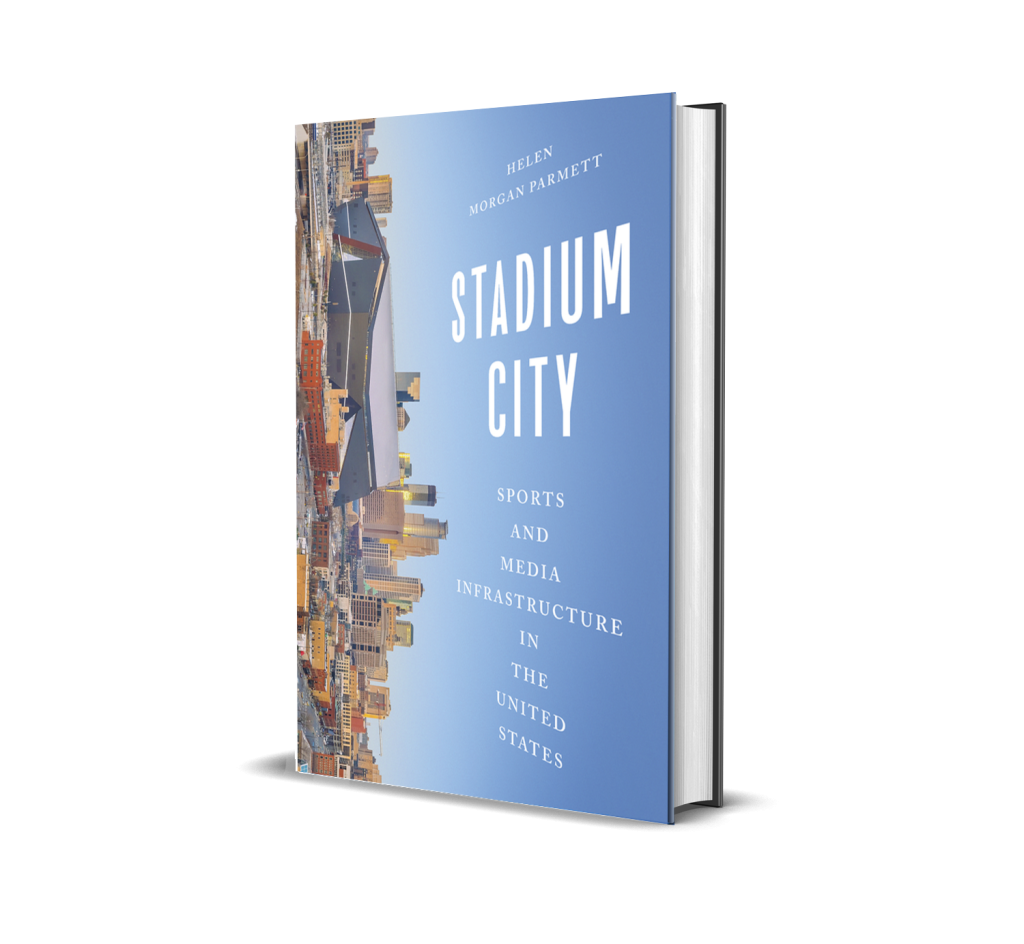Helen Morgan Parmett, author of Stadium City: Sports and Media Infrastructure in the United States, answers questions about her new book.

Q: Why did you decide to write this book?
I was in Seattle for an academic conference, and I booked a hotel in Pioneer Square adjacent to the stadiums. I didn’t know this when I booked it. At the time, I was writing about New Orleans and the role of media production in post-Katrina urban regeneration, and my friend and colleague, with whom I was staying in the hotel, was writing about sports fandom. Walking around the neighborhood, we were struck by how influenced it was by the sports stadiums—how it mediated Pioneer Square’s “old town” branding, social services agencies serving vast numbers of people experiencing homelessness in the neighborhood, and the spectacles of football and baseball. Those conversations turned into an idea for a conference presentation, and further discussions led to an idea for a book. However, my colleague ended up dropping out of academia and, hence, the book project, early on. I therefore put the book aside for several years. However, every city I traveled to, I kept being struck by their stadium infrastructure and the ways in which they implicated city space and senses of place. When a colleague asked me to contribute to the edited collection White Supremacy and American Media (Routledge), I decided to turn back to this project and think through what new directions I might go in without my colleague as my co-author. The chapter for that collection reignited my interest in the book, where I pivoted theorizing the stadium as an urban media infrastructure. As I started writing the book, everyone I spoke to kept telling me that what was happening in their city sounded just like what I was writing about. It was then that I knew I was onto something and that I had to complete the book.
Q: What is the most interesting discovery you made while researching and writing your book?
One of the things that was an unexpected joy in this research was discovering letters written into city mayors and city council members from constituents regarding planned sporting infrastructure. These were letters written by everyday people, who recognized themselves as stakeholders in the plan, even though their voices were rarely considered as relevant in the planning process. Still, they took the time to express their views and concerns by writing into their political officials. Their voices tell a story of the history of sporting infrastructure in cities that is rarely heard, whether for or against the stadium. In addition to the letters, the Seattle Municipal Archives also connected me to a set of archived hearings around the parking plan for the stadiums proposed to replace the Kingdome. Organizers from the nascent Asian-American movement in Seattle at the time testified at the hearing, and their testimonies were deeply moving and affecting. Similarly, at the James G. Kenan Research Center at the Atlanta History Center, I found an archival document derived from an oral history project conducted by Booker T. Washington High School Students of neighborhood residents who would be affected by the building of the Georgia Dome. Similar to the letters and the hearing testimony, the oral histories provided rare insight into the thoughts and feelings of residents whose voices were rarely spotlighted in debates about the stadium. I felt grateful to get to read/hear/listen to them, and a responsibility to do them justice in their retelling.
Q: What myths do you hope your book will dispel or what do you hope your book will help readers unlearn?
Myth: That sports stadiums only matter for sports fans
Fact: Sports stadiums implicate every resident of a city and their visitors, whether they ever step foot in a stadium or not. This is because the stadium is bound up with a city’s infrastructure and deeply connected to its culture and constitution of place
Q: Which part of the publishing process did you find the most interesting?
The research. I take true joy in digging into the research, whether that is looking through archival materials, conducting interviews, or site visits. I appreciate the ways in which this research challenges my preconceived assumptions, pushes my questions wider, connects me to new areas of thinking, and forces me to find the thread that connects them.
Q: What is your advice to scholars/authors who want to take on a similar project?
Go to the archives! When I told other scholars that a core part of my research for this book was in the archives, they were surprised. “Aren’t you writing about these new stadiums?” Yes, that was my goal, but I also came to realize that these new stadiums could not be understood outside of the histories and the earlier iterations of stadiums from which they emerged. Archives can feel elite, stuffy, and exclusionary, but I’ve found that the people who work in these archives are unbelievably kind and helpful. They are excited about what their collections hold and to try to connect researchers to material that they may find interesting, inspiring, and helpful. They work tirelessly to reconsider what is in their collections and to collect materials from people who don’t see their lives as worthy of archiving. Though archives are incomplete and products of power relations, they often hold nuggets of marginalized and forgotten histories, such as in the letters to the mayor and city council members I found for this project.
Q: What do you like to read/watch/or listen to for fun?
I love television! I love serialized, “guilty pleasure” television, including reality TV and other kinds of soap-opera derived television. But I have no guilt in my love. I enjoy keeping up with my favorite sports, especially tennis!
Helen Morgan Parmett is the Edwin W. Lawrence Endowed Professor of Forensics and an associate professor of English at the University of Vermont. She is the author of Down in Treme: Race, Place, and New Orleans on Television.
